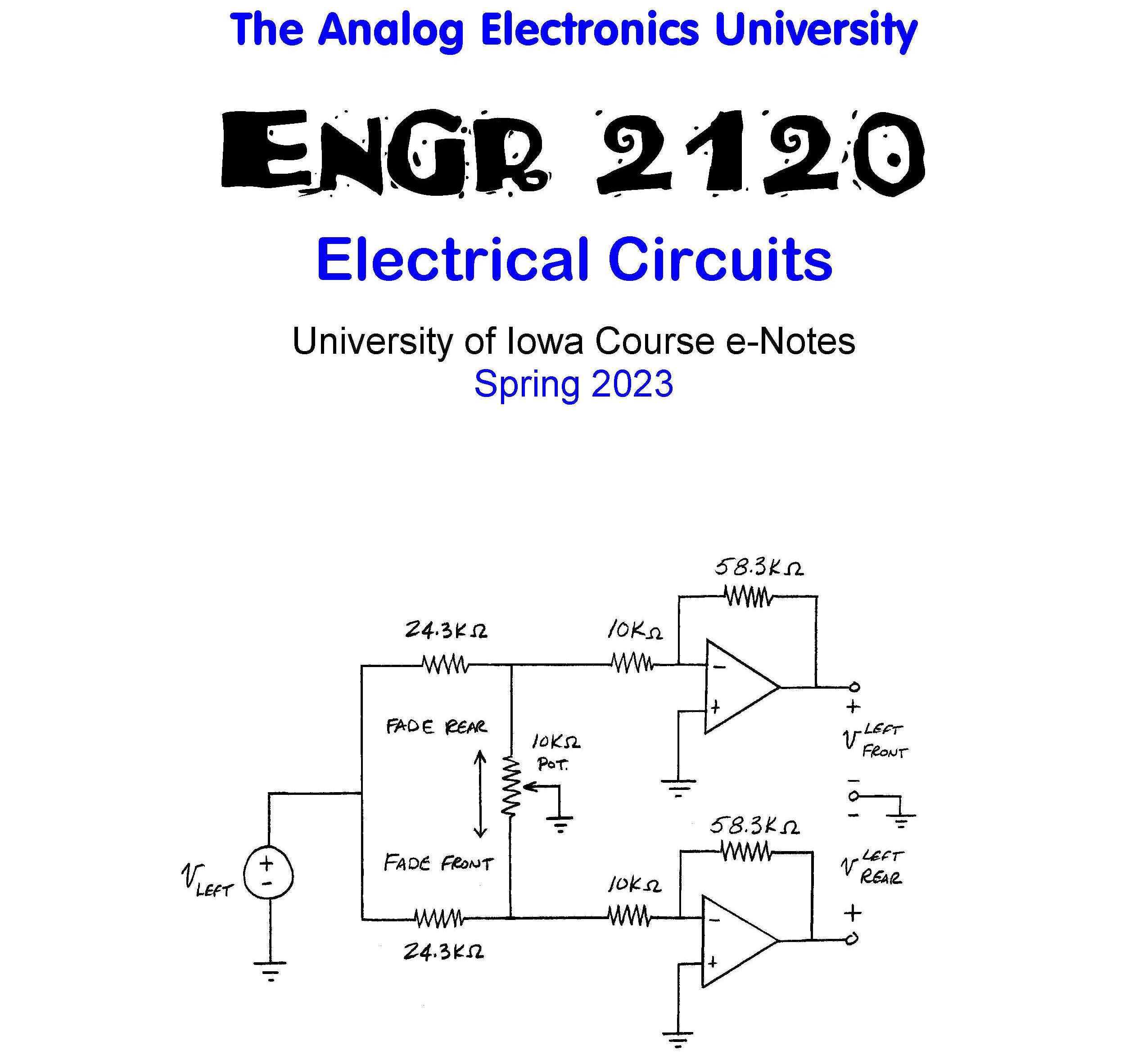Description
ENGR 2120: Electrical Circuits is a 3-credit course taught at the University of Iowa for Engineering majors. The catalog description for this course is: Kirchhoff’s laws and network theorems; analysis of DC circuits; first order transient response; sinusoidal steady-state analysis; elementary principles of circuit design; SPICE analysis of DC, AC, and transient circuits.
The companion textbook used in this course is: James W. Nilsson & Susan Riedel, Mastering Engineering with Pearson etext for Electric Circuits, 2023 (12th Edition)
Table of Contents
Chapter 1: Introduction
1.1 About This Book
1.2 Symbols and Units
Prefixes, Engineering Notation
1.3 Circuit Variables
Current, Voltage, Power, Passive Sign Convention, Ground, Conservation of Energy, Conservation of Power
Chapter 1: Supplemental Problems and Solutions
S1.1, S1.2, S1.3, S1.4
Chapter 2: Basic Circuit Analysis
2.1 Element Constraints
Electrical Network, Circuit, Resistance, Ohm’s Law, V-I Characteristics, Conductance, Power, Resistor, Color Code, Precision Resistors, Ratings, Open and Short Circuits, Switches, Independent Voltage Sources, Independent Current Sources
2.2 Connection Constraints
Kirchhoff’s Current Law, Kirchhoff’s Voltage Law
2.3 Combined Constraints
Assigning Reference Marks
2.4 Equivalent Circuits
Series Resistance, Parallel Resistance, Special Cases, Approximations, Equivalent Voltage Sources, Equivalent Current Sources, Source Transformations, Delta-to-Wye and Wye-to-Delta Transformations, Redundant Elements
2.5 Voltage and Current Division
Voltage Divider Rule, Special Cases, Potentiometers, Current Divider Rule, Special Cases, Meter Movements, Wheatstone Bridge
Chapter 2: Supplemental Problems and Solutions
S2.1, S2.2, S2.3, S2.4, S2.5, S2.6, S2.7, S2.8, S2.9, S2.10, S2.11, S2.12, S2.13, S2.14, S2.15, S2.16, S2.17, S2.18, S2.19, S2.20, S2.21, S2.22, S2.23, S2.24
Chapter 3: Circuit Analysis Techniques
3.1 Node-Voltage Analysis
Element Inspection Rule, Writing Node Equations by Inspection, Cramer’s Rule, Evaluating Determinants, Node Analysis with Voltage Sources, Supernode
3.2 Mesh-Current Analysis
Element Inspection Rule, Writing Mesh Equations by Inspection, Mesh Analysis with Current Sources, Supermesh
3.3 Linearity Properties
Superposition Principle, Proportionality Property, Transfer Function, Unit Output Method
3.4 Thevenin and Norton Equivalent Circuits
Thevenin’s Theorem, Norton’s Theorem, Relationships
3.5 Maximum Signal Transfer
Second Derivative Test, Maximum Power Transfer Theorem, Maximum Efficiency Theorem, Computer-Aided Circuit Analysis
2.7 Computer-Aided Circuit Analysis
SPICE, MATLAB
Chapter 3: Supplemental Problems and Solutions
S3.1, S3.2, S3.3, S3.4, S3.5, S3.6, S3.7, S3.8, S3.9, S3.10, S3.11, S3.12, S3.13, S3.14
Chapter 4: Active Circuits
4.1 Linear Dependent Sources
Voltage Controlled Sources, Current Controlled Sources, SPICE Models
4.2 Analysis of Circuits with Dependent Sources
Node-Voltage Analysis, Mesh-Current Analysis, Thevenin and Norton Equivalent Circuits
4.4 The Operational Amplifier
Notation, Ideal and Commercial Op-Amps, Non-inverting Amplifier, Zero Volt – Zero Current Property, Modeling a Non-inverting Amplifier, Limitations Due to the Power Supply, Voltage Follower, Inverting Amplifier and Model, Differential Amplifier and Model, Op-Amp Circuit Analysis, Bridge-T Amplifier
Chapter 4: Supplemental Problems and Solutions
S4.1, S4.2, S4.3, S4.4, S4.5, S4.6, S4.7, S4.8, S4.9, S4.10, S4.11, S4.12, S4.13, S4.14, S4.15
Chapter 6: Capacitance and Inductance
6.1 The Capacitor
V-I Relationship of Capacitance, Plotting Power and Energy with SPICE, Capacitor, Modeling a Capacitor with Ideal Elements
6.2 The Inductor
V-I Relationship of Inductance, Plotting Power and Energy with SPICE, Inductor, Modeling an Inductor with Ideal Elements
6.4 Equivalent Capacitance and Inductance
Series and Parallel Combinations of Capacitance, Series and Parallel Combinations of Inductance
Chapter 6: Supplemental Problems and Solutions
S6.1, S6.2, S6.3, S6.4, S6.5, S6.6
Chapter 7: First- and Second-Order Circuits
7.2 First-Order Circuit Step Response
Step Response of an RC Circuit, Algorithm for any One Capacitance Circuit, Time Constant, Interpretation of the Time Constant, Step Response of an RL Circuit, Algorithm for any One Inductance Circuit, Time Constant, Sequential Switching, Algorithm for Sequential Switching, PSpice Simulation with Switches
7.4 First-Order Circuit Sinusoidal Response
Natural and Forced Response, RC Circuits
7.5 The Series RLC Circuit
Natural Response, Characteristic Equation, Overdamped, Critically Damped and Underdamped Response, SPICE
7.6 The Parallel RLC Circuit
Natural Response, Characteristic Equation, Overdamped, Critically Damped and Underdamped Response, SPICE
7.7 Second-Order Circuit Step Response
Complete Response of a Series RLC Circuit with a Step and Sinusoidal Input, SPICE, Complete Response of a Parallel RLC Circuit with a Step and Sinusoidal Input.
Chapter 7: Supplemental Problems and Solutions
S7.1, S7.2, S7.3, S7.4, S7.5, S7.6, S7.7
Chapter 8: Sinusoidal Steady-State Response
5.4 The Sinusoidal Waveform
Cycle, Period, Frequency, Amplitude, Phase Angle
8.1 Sinusoids and Phasors
Vector Representation of Sinusoids, Euler’s Formula, Complex Numbers, Rectangular and Polar Form, Phasor Transform, Inverse Phasor Transform, Addition- Subtraction- Multiplication-Division of Complex Numbers
8.2 Phasor Circuit Analysis
Kirchhoff’s Current Law, Kirchhoff’s Voltage Law, Resistance in Phasor Form, Capacitance in Phasor Form, Inductance in Phasor Form, Impedance, Admittance
8.3 Basic Circuit Analysis with Phasors
Series Equivalence of Impedances, Reactance, Phasor Analysis Algorithm, Voltage Divider Rule, Parallel Equivalence of Impedances, Susceptance, Current Divider Rule, SPICE, Resonant Frequency of an Impedance, Series Resonance, Parallel Resonance
8.4 Circuit Theorems with Phasors
Superposition, Source Transformations, Thevenin and Norton Equivalent Circuits
8.5 General Circuit Analysis with Phasors
Node-Voltage Method, MATLAB, Mesh-Current Method
8.6 Energy and Power
Average Power for a Resistance, Inductance and Capacitance, Root-Mean-Square
Chapter 8: Supplemental Problems and Solutions
S8.1, S8.2, S8.3, S8.4, S8.5, S8.6, S8.7, S8.8, S8.9, S8.10, S8.11, S8.12, S8.13, S8.14, S8.15, S8.16, S8.17
Chapter 15: Mutual Inductance
15.1 Coupled Inductors
Magnetic Flux, V-I Characteristics
15.2 The Dot Convention
Examples of Coupled Coils
15.3 Energy Analysis
Coupling Coefficient
15.4 The Ideal Transformer
Perfect Coupling, Equivalent Input Resistance
15.5 Transformers in Sinusoidal Steady-State
S-Domain Model, SPICE Model
Chapter 15: Supplemental Problems and Solutions
S15.1, S15.2, S15.3, S15.4, S15.5
Chapter 16: Power in Sinusoidal Steady-State
16.1 Average and Reactive Power
16.2 Complex Power
Apparent Power, Power Factor, Reactive Power Factor, Power Factor Angle, Power Triangle, Complex Power and Load Impedance
16.3 AC Power Analysis
Conservation of Complex Power Theorem, Power in Purely Resistive Circuits, Power in Purely Capacitive Circuits, Power in Purely Inductive Circuits
16.4 Load-Flow Analysis
Power Factor Correction, Step-up and Step-Down Transformers, Maximum Real Power Transfer Theorem
16.5 Three-Phase Circuits
Three-Phase Voltage Sources, Phase Sequence, Line / Phase Relationships
16.6 Three-Phase AC Power Analysis
Y-Connected Source and Y-Connected Load, Y-Connected Source and Δ- Connected Load
Chapter 16: Supplemental Problems and Solutions
S16.1, S16.2, S16.3, S16.4, S16.5
